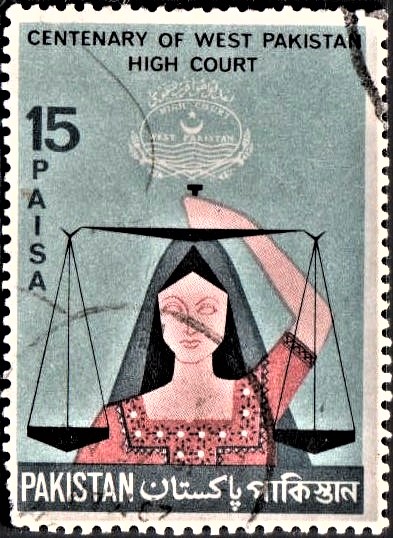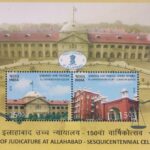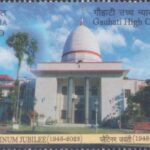
High Court of West Pakistan
A commemorative postage stamp on the Centenary of the High Court of West Pakistan :
 Issued by Pakistan
Issued by Pakistan
Issued on Feb 17, 1967
Design : The theme of the design is ‘Justice’ which is symbolized by a woman holding the ‘Scale of Justice’ in the left hand. The West Pakistan High Court insignia is shown in reverse, above the head of the woman, against a background of light blue. The word ‘Pakistan’ in English, Bengali and Urdu is shown in reverse in a dark blue panel at the bottom. The wording “Centenary of West Pakistan High Court” appears at the top in black. The denomination figure ‘15’ appears at the left hand side with ‘Paisa’ written vertically beneath it.
Type : Stamp, Postal Used
Denomination : 15 Paisa
Colour : Light Blue, Dark Prussian Blue, Indian Red and Black
Size of stamp : 44.5 x 32.5 m.m.
Size of print : 41.5 x 29.5 m.m.
Perforation gauge : 13 x 13 (c)
Quantity printed : 15,00,000
Number of stamps in each sheet : 50
Process of Printing : Litho Offset
Printers : The Pakistan Security Printing Corporation Ltd., Karachi
About :
- The Centenary Celebrations of the permanent seal of the High Court of West Pakistan will be held at Lahore in February, 1967. The High Court actually completed its centenary in February 1966, but due to emergency, the Centenary Celebrations could not be held.
- The history of the High Court at Lahore is a saga of the march of social, political and constitutional events over a turbulent period of 101 years relating to one of the northern Provinces of the Undivided British India called the Punjab.
- In order to trace this Court’s constitutional development, one must start from the period when the territory of the Punjab was transferred from Maharajah Dalip Singh to the East India Company in 1849. In that year a Board of Administration was set up constituting of three members, joint in all important matters, but each having separate charge of the Political, Revenue and Judicial Administration respectively, in the territory. This system was simple and well-suited to the early period and continued for a few years.
- In 1853, the Board of Administration was abolished and the Chief Commissionership established. A Chief Commissioner was appointed at the apex of all authority. Two other officers, designated ‘Principal Commissioners’ were appointed for the Judicial and Financial Branches of the Administration. The First Judicial Commissioner was Sir Robert Montgomery, who afterward became the Lieutenant–Governor of the Punjab. During the period of this Chief Commissionership, simple and intelligible principles of law were laid down and justice was made speedy and effective.
- It was not until 1864 that the need for expanding the Judicial Machinery in the Punjab was keenly felt. In December of that year, the Hon’ble Mr. Cust introduced into the Governor General’s Council a Bill for the formation of the Chief Court of the Punjab. Accordingly, the Chief Court Act, XXIII of 1865, was passed, but on technical grounds it was found necessary to re-enact the same.
- On 16th February, 1866, the new Chief Court Act, IV of 1866, received the assent of the Governor General and came into operation on 17th February, 1866. On the 19th February, 1866, Mr. A. A. Roberts, Senior Judge, and Mr. Charles Boulnois, Barrister Judge, entered upon the execution of their offices. Thus was laid the foundation of the Supreme Court of the Province.
- The Chief Court of the Punjab was constituted as the ultimate Court of appeal from the civil and criminal courts in the Province and was also vested inter alia with extraordinary, original civil jurisdiction, supervisory jurisdiction over sub-ordinate courts, and the power to try European British Subject committed to it for trail in lieu of the High Court at Fort William in Bengal.
- Two important innovations that came about in 1866 exercising a powerful influence on the judicial system may also be stated. The first was the application of the Civil Procedure Code in the province and the second was the admission of Pleaders to practise in the courts. By the end of 1866, six European and two ‘native’ Pleaders were admitted to practise in the courts. The periodical publication of decisions of the Chief Court was also begun.
- The Court was started with two judges but till the time its status was raised to that of a High court, it was working with a complement of five permanent and four temporary additional judges.
- The conversion of the Chief Court to a High Court was not achieved without labour and effort. From 1888, the Chief Court had been submitting memorials to the Punjab Government in this respect, but the finance of the Province were not sound enough to meet the extra expenditure involved, consequent on the change intended. It was only when the financial position improved that in 1916 the Secretary of State for India gave some indication that the Chief Court would be converted into a High Court as soon as possible after the end of the War. It was not until December 1918, that the Chief Court finally received intimation that the conversion of the Court would possibly take effect in April 1919. A copy of the Letters Patent, constituting the High Court of Judicature at Lahore was formally presented to the Chief Justice of the Court at Lahore on the 1st of April 1919. By the Letters Patent, the High Court was given jurisdiction over the Province of the Punjab and Delhi. It was constituted the highest appellate authority in civil and criminal cases. It was granted extra-ordinary civil and criminal jurisdiction and was also vested inter alia with original jurisdiction in matrimonial, probate and administration matters.
- The High Court of Judicature at Lahore, which originally started with one Chief Justice and six Puisne Judges, soon found itself overburdened with work. With the rapid advance of education and prosperity in the Province, the Court’s work increased manifold and the permanent strength had to be increased from time to time and temporary additional Judges had to be appointed to keep the backlog of pending cases under check. By the time of the Partition of the Punjab the Court possessed fifteen permanent and additional judges.
- With the Partition of British India in 1947, the Province of the Punjab was divided; 58,055 Sq. Miles were apportioned to the share of West Punjab in Pakistan and 38,631 Sq. Miles to the share of East Punjab in India. The rights, powers and privileges as hitherto enjoyed and possessed by the High Court of Judicature at Lahore for the Undivided Province were preserved for the portion of the territory falling to the share of West Punjab, in Pakistan. A new High Court of Judicature for East Punjab, to be located in that portion of the truncated territory falling to the share of India, was created by His majesty the King Emperor, and the pending files with the High Court of Judicature at Lahore were distributed between itself and the east Punjab High Court depending upon where the originating courts, from which the proceedings pending in the High Court had first initiated, were situated. With the Partition, the strength of the High Court of Judicature at Lahore was reduced to a complement of seven Judges.
- In 1954 an amendment made in the Government of India Act, 1935, gave writ jurisdiction to the High Court of Judicature at Lahore, and the Chief Court of Sind. The effect was electrifying. There was an immediate increase in work as the litigants found a new, cheap and effective avenue of redress.
- In 1955 the Province of West Pakistan was created. This was brought about by the merger of (i) The Governor’s Provinces of the Punjab, North–West Frontier and Sind, (ii) The Chief Commissioner’s Province of Baluchistan and the Capital of the Federation, (iii) The states of Bahawalpur and Khairpur, and the Baluchistan States Union and (iv) The Tribal Areas of Baluchistan, the Punjab and the North-West Frontier and the States of Amb, Chitral, Dir and Swat, into one compact territorial unit called the Province of West Pakistan. Side by side, a High Court for the Province of West Pakistan was created to replace the High Court of Judicature at Lahore, the Chief Court of Sind, the Judicial Commissioner’s Courts in North-West Frontier Province and Baluchistan and the High Courts of the states of Bahawalpur and Khairpur. The powers and authority exercisable by the old High Court of Judicature at Lahore and the Judges thereof were made exercisable by the High Court of West Pakistan and its Judges for the whole of the Province of West Pakistan.
- By the territorial unification brought about in 1955 the jurisdiction of the High Court of West Pakistan extended to 203,257 Sq. Miles. Two permanent Benches were created for Karachi and Peshawar and two Circuit Benches for Quetta and Bahawalpur, which still exist and function today. The total complement of Judges of the High Court of West Pakistan today is roughly thirty-one, with roughly nineteen Judges working at the permanent seat of the Court at Lahore.
- Originally in 1866 the Chief Court was located in a building adjacent to Anarkali’s Tomb. In September 1887, the Chief Court shifted to its new premises on the Upper Mall where the High Court now stands. Initially, the main building was built in the form of a quadrangle, but due to pressure on accommodation, two new blocks were added in 1923 at the North-East and North-Western corners of the quadrangle, so as to form with the main building, three sides of another quadrangle open towards the Mall. Plans for the erection of a new third block at the South-East corner of the main building are under way to relieve the further congestion prevailing today.
- The High Court building though constructed in Indo-Saracenic style, still harmonises admirably with the history and atmosphere of Lahore and its monuments. Situated opposite the General Post Office and facing the Upper Mall, it presents an imposing and fascinating picture of beauty and serenity, which a passerby cannot fail to notice and appreciate.
- Looking back over the years, one cannot help but recall to mind the services rendered by eminent Judges who have contributed to the integrity and prestige of the Court as it exists today. Mr. Charles Boulois, Sir Meredyth Plowden, Sir Charles Roe, Sir William and Sir Henry Rattigan, Sir Shadi Lal, Bakhshi Sir Tek Chand, Dr. Mehr Chand Mahajan, Sir William Clark, Sir Arthur Reid, Sir Abdul Rashid, Sir Muhammad Abdur Rahman, Mr. Muhammad Munir, Mr. A. R. Cornelius, Dr. S. A. Rahman and Mr. Muhammad Rustam Kayani are some of the numerous company of great Judges who have left the impress of their personality and integrity on the Court and whose influence is and will be continuously felt.
- With the compliments of the Director-General, Pakistan Post Office, Karachi.







